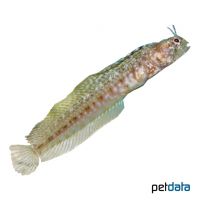Sailfin Blenny (Emblemaria pandionis)
| Sailfin Blenny Emblemaria pandionis | |
|---|---|
| Name | Sailfin Blenny |
| Name Lat. | Emblemaria pandionis |
| Family | Chaenopsids |
| Family lat. | Chaenopsidae |
| Order | Blennies |
| Order lat. | Blenniiformes |
| Origin | Western Atlantic |
| Habitat | Reefs |
| Diet | Planktivore |
| pH | 8.1-8.4 |
| Hardness | 8-10 °KH |
| Behavior | Peaceful |
| Keeping | Individual, group |
| Reef Compatible | Yes |
| Care Level | Moderate |
| Life Span | N/A |
| Protection | No |
| Metric Units | |
| Size | 5 cm |
| Temperature | 22-28 °C |
| Salinity | 33-36 ‰ |
| Aquarium | ~ 200 l |
| US Units | |
| Size | 2" |
| Temperature | 72-82 °F |
| Salinity | 1.020-1.025 sg |
| Aquarium | ~ 50 gal |
Distribution and habitat
The range of Emblemaria pandionis is in the western Atlantic, extending from Florida through the Gulf of Mexico and the Caribbean islands to Venezuela, where they live in clear, shallow water on rocky shores and coral reefs and over coral rubble, preferring empty tubes of invertebrates (tubeworms, clams).
Maintenance
They require a well-structured aquarium with a reef structure that provides numerous tubular hiding places and live stones that act like a biological filter. Only lime-rich, heavy metal-free sands, gravels, stones or sea sand may be used.
Filters, skimmers and heaters are necessary to ensure water quality, as well as pumps to simulate tides, swells and bottom currents. Lighting must be appropriate for the species' day-night rhythm
| Salinity: 33-36 ‰ | pH value: 8.1-8.4 |
| Carbonate hardness: 8-10 °KH | Nitrate content: 2-8 mg/l |
| phosphate content: 0.01-0.1 mg/l | nitrite content: 0.0-0.05 mg/l |
For salinity, an average value should be aimed for, which may only vary slightly by +/- 0.5 ‰. Ammonia and ammonium must not be measurable. Special attention must be paid to consistently good water quality and water values.
Diet
In nature they feed mainly on zooplankton. The feed change usually succeeds without problems. The food supply should consist of a commercially available, vitamin-enriched, frozen special food mix for plankton eaters, supplemented with live and frozen food such as mysis, artemia, etc. as well as high-quality flake or granulated food, which is usually well accepted after an acclimatization phase
It is recommended to feed small portions several times a day (3-5 times). Regular and varied feeding promotes health and increases resistance.
Behaviour and compatibility
They are shy animals. The males behave very territorial, they can be kept together with several females. Keeping several males is only recommended in a larger and well structured aquarium. Towards other fish they behave peacefully and they should be socialized only with calm, non-aggressive animals.
Sex dimorphism
Males are darker in color and have a larger dorsal fin than females.
Reproduction and breeding
There are no known reports of successful breeding in the aquarium. Presumably the brood care takes place in the living tubes.
Important
They need narrow tubes as living and hiding places, also empty snail shells or artificial "boreholes", if length, diameter and angle of inclination fit, are accepted.
As coral reef dwellers, they should not be kept in a fish-only aquarium
If different species are kept together, care should be taken to match the fish in terms of water quality and temperature requirements and social behavior, and to ensure that the setup meets the needs of all species kept together. New fish to be introduced must be acclimated slowly to the water in the aquarium
Further literature can be found in your pet store.
References
Text: Werner Winter; Image: petdata
Source: KUITER, DEBELIUS (2007): Atlas der Meeresfische: Die Fische an den Küsten der Weltmeere, Kosmos Verlag; ENGELMANN (2005): Zootierhaltung - Tiere in menschlicher Obhut: Fische, Verlag Harri Deutsch
- Gemäß § 21 Abs. 5 Tierschutzgesetz idgF
